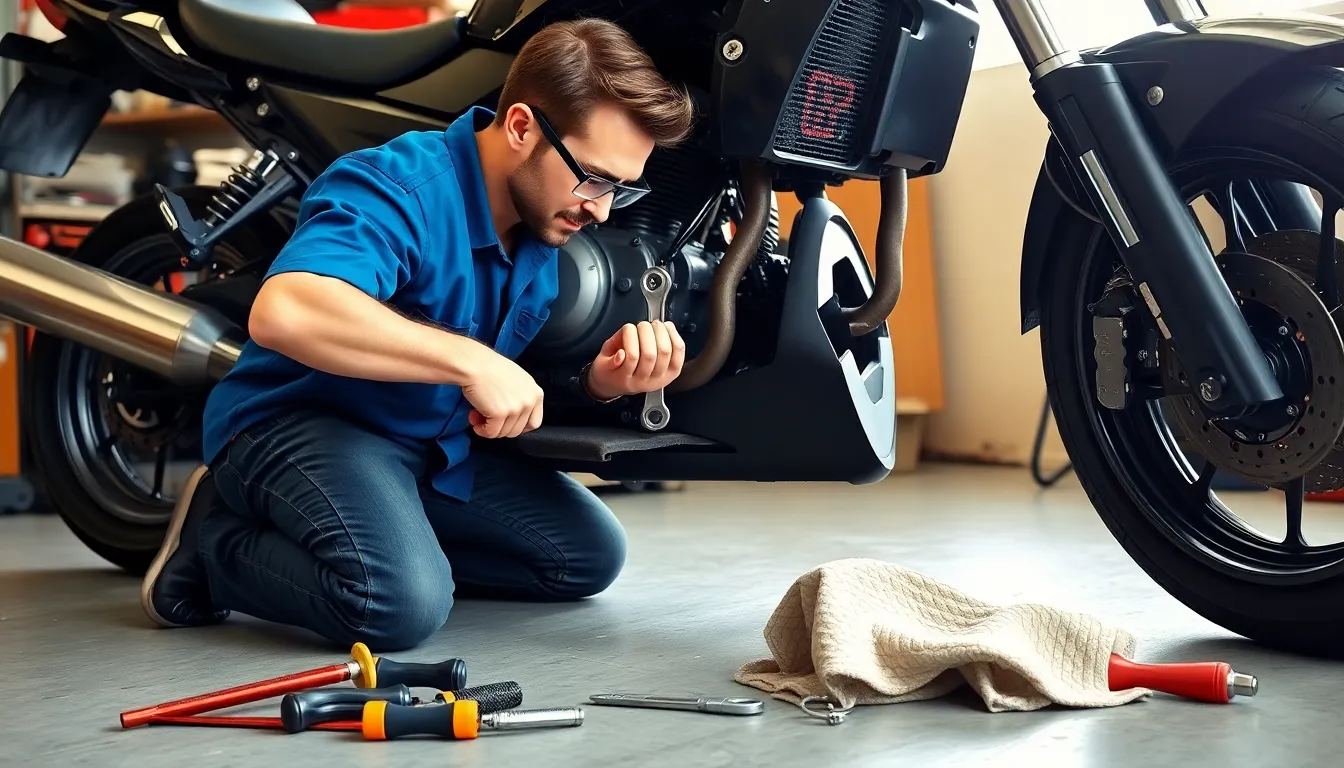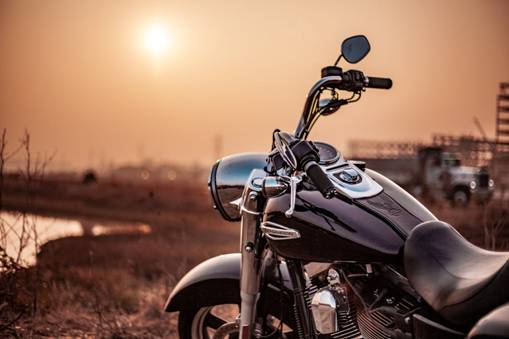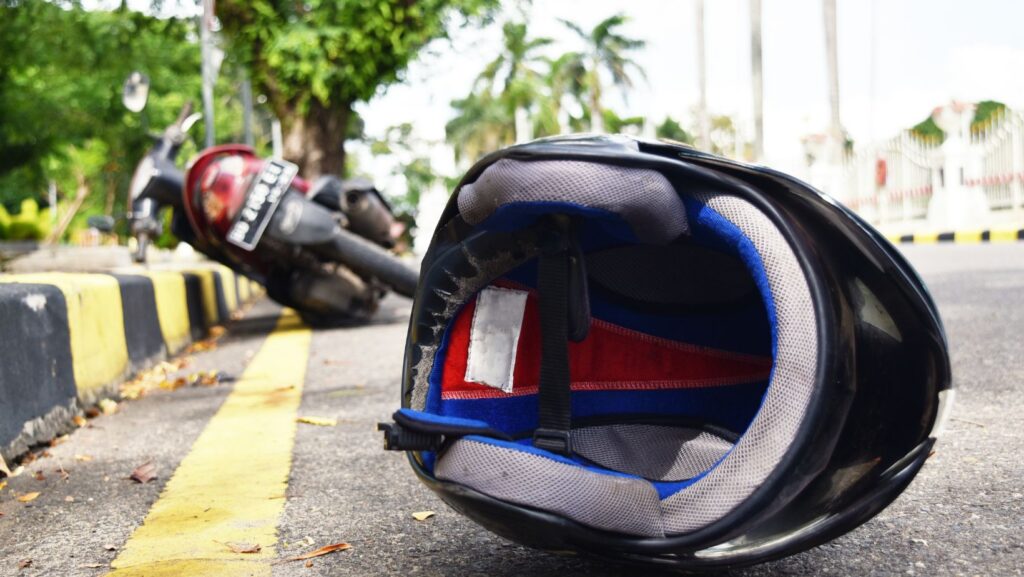Tuning up a motorcycle isn’t just about keeping it running; it’s about unleashing the beast within. Picture this: a smooth ride, the wind in your hair, and the engine purring like a content cat. But without a proper tune-up, that dream can quickly turn into a nightmare of sputtering and stalling.
How To Tune Up A Motorcycle
Tuning up a motorcycle involves more than just routine check-ups. It’s a vital process that maintains performance and reliability.
Importance of Regular Maintenance
Regular maintenance keeps a motorcycle operating efficiently. It prevents costly repairs and ensures safety on the road. Scheduled tune-ups enhance fuel efficiency, improve handling, and extend the life of the bike. Mechanics typically recommend a tune-up every 3,000 to 5,000 miles or as specified in the owner’s manual. This practice helps riders enjoy a smooth experience, avoiding breakdowns during rides.
Signs Your Motorcycle Needs a Tune-Up
Several indicators signify that a motorcycle requires a tune-up. Difficulty starting often signals an issue with the battery or fuel system. Reduced acceleration can indicate problems with spark plugs or air filters. Unusual noises while riding may hint at mechanical issues that need attention. Additionally, increased fuel consumption suggests that maintenance is overdue. Riders should also be aware of changes in handling or steering, which could mean a check-up is necessary. Addressing these signs promptly maintains optimal performance and safety.
Essential Tools for Tune-Up

Having the right tools is crucial for a successful motorcycle tune-up. Proper equipment promotes efficiency and ensures thorough maintenance.
Basic Tools Required
Basic tools include essential items like screwdrivers, wrenches, and pliers. Screwdrivers come in various sizes to fit different fasteners. Wrenches are necessary for tightening bolts and nuts, while pliers assist in gripping components securely. A torque wrench is vital for achieving precise tension on fasteners, promoting safety. Additionally, a clean cloth and oil filter wrench aid in routine maintenance tasks. Measuring tools like a ruler or caliper help check wear on parts, establishing the need for replacements. Finally, a service manual is invaluable for following specific manufacturer guidelines and procedures.
Optional Tools for Advanced Tune-Up
Optional tools enhance the tuning process, allowing for a more in-depth analysis. A multimeter measures voltage and current, aiding in electrical system diagnostics. A carburetor synchronizer ensures that each cylinder receives the same amount of fuel and air for optimal performance. Oil extractors simplify fluid changes, making the task quicker and cleaner. Tire pressure gauges help maintain correct tire inflation, promoting handling and safety. Digital gauges provide accurate readings for air-fuel mixtures, indicating adjustment needs. An exhaust gas analyzer gauges emissions, identifying engine efficiency issues that require attention.
Step-By-Step Guide to Tune Up a Motorcycle
Tuning up a motorcycle involves several crucial steps. Each procedure enhances performance and prolongs the bike’s lifespan.
Checking and Replacing Spark Plugs
Spark plugs ignite the air-fuel mixture in the engine. Regularly inspecting them ensures optimal combustion. Removing the spark plugs requires a socket wrench. Check for wear indications such as carbon buildup or damage. Replace them if they’re worn out, typically every 8,000 to 10,000 miles, or as specified in the owner’s manual. Iridium or platinum plugs last longer and maintain efficiency.
Adjusting the Carburetor
The carburetor regulates the air-fuel mixture entering the engine. Adjusting it can improve fuel efficiency and performance. Begin by checking the owner’s manual for specific adjustments. Use a carburetor synchronizer for multi-cylinder engines to ensure equal performance across cylinders. Inspect the choke and throttle cables for proper function. Fine-tuning these settings improves ride quality noticeably.
Inspecting and Changing Oil and Filter
Oil lubricates internal engine components. Changing the oil and filter regularly is essential for engine health. Start by warming the engine slightly to thin the oil, allowing for easier drainage. Remove the old oil filter using an oil filter wrench. Replace it and refill the engine with high-quality motor oil, typically every 3,000 to 5,000 miles. Following the manufacturer’s guidelines ensures optimal performance.
Evaluating the Air Filter
The air filter prevents dirt and debris from entering the engine. A clogged air filter decreases performance and fuel efficiency. Remove the filter and inspect for dirt or damage. Cleaning a washable filter using mild soap can often restore it. Replace it if significant wear is present. Regular checks, ideally every 3,000 miles, ensure sufficient airflow to the engine.
Examining Tire Pressure and Condition
Tire pressure affects handling, stability, and safety. Check tire pressure regularly with a tire gauge, usually recommended between 28 to 36 psi depending on the bike. Inspect the tires for wear patterns, cuts, or bulges. Proper tread depth, at least 2/32 inches, ensures grip and safety on the road. Replacing worn tires enhances both performance and safety significantly.
Final Checks and Testing
Final checks and testing are crucial steps in the motorcycle tuning process. Ensuring everything is functioning perfectly enhances safety and performance on the road.
Ensuring Brakes Function Properly
Brakes play a vital role in motorcycle safety. Begin by inspecting brake fluid levels and checking for leaks in the system. Examine the brake pads for wear. If the pads are thinner than 1/16 inch, they’re due for replacement. Look at the brake lines for signs of damage or deterioration. Testing the brake response is equally critical; the brakes should engage smoothly without any sponginess. Replace worn or faulty components immediately to maintain optimal stopping power. Ensuring that both front and rear brakes operate effectively maintains rider safety during rides.
Taking a Test Ride
Taking a test ride verifies the outcome of the tune-up. During the ride, pay attention to how the motorcycle responds under various conditions. Listen for any unusual noises, such as rattling or grinding sounds, which may indicate mechanical issues. Accelerating from a complete stop tests engine performance and throttle response. Additionally, evaluate turning stability and braking efficiency. Ensure the bike handles confidently at slow and high speeds. Document any unusual behaviors or sensations experienced during the ride. Address any concerns identified to guarantee the motorcycle operates reliably before hitting the road.
Tuning up a motorcycle is essential for anyone who values performance and safety. By regularly addressing maintenance needs and following a structured tune-up process, riders can enjoy a smoother and more efficient ride. This not only enhances the motorcycle’s lifespan but also significantly improves the overall riding experience.
It’s important to stay vigilant for signs that indicate a tune-up is needed, as prompt action can prevent more serious issues down the line. With the right tools and a thorough understanding of the tuning process, motorcycle owners can take charge of their bike’s health and performance. Ultimately, a well-tuned motorcycle is not just about maintenance; it’s about maximizing enjoyment on every ride.



